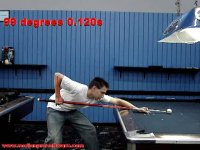Fellow BCA instructors exactly where do you reference to check the 90 degree angle when reviewing side angle video of a students elbow/forearm to cue stick?
1. Center of elbow to middle hand knuckle OOIOO________>cueball?
2. Center of elbow to middle of first knuckle of pointer finger OOOI_______>cueball?
3. Outside elbow to center knuckle?
Hopefully this makes sense. Please explain why.
To me this seems some what important to reference in order to make sure fore arm is at true 90 degrees to cue stick.
My thought is middle elbow to center of pointer finger knuckle.
Thanks for responding
Earl Munson
1. Center of elbow to middle hand knuckle OOIOO________>cueball?
2. Center of elbow to middle of first knuckle of pointer finger OOOI_______>cueball?
3. Outside elbow to center knuckle?
Hopefully this makes sense. Please explain why.
To me this seems some what important to reference in order to make sure fore arm is at true 90 degrees to cue stick.
My thought is middle elbow to center of pointer finger knuckle.
Thanks for responding
Earl Munson
